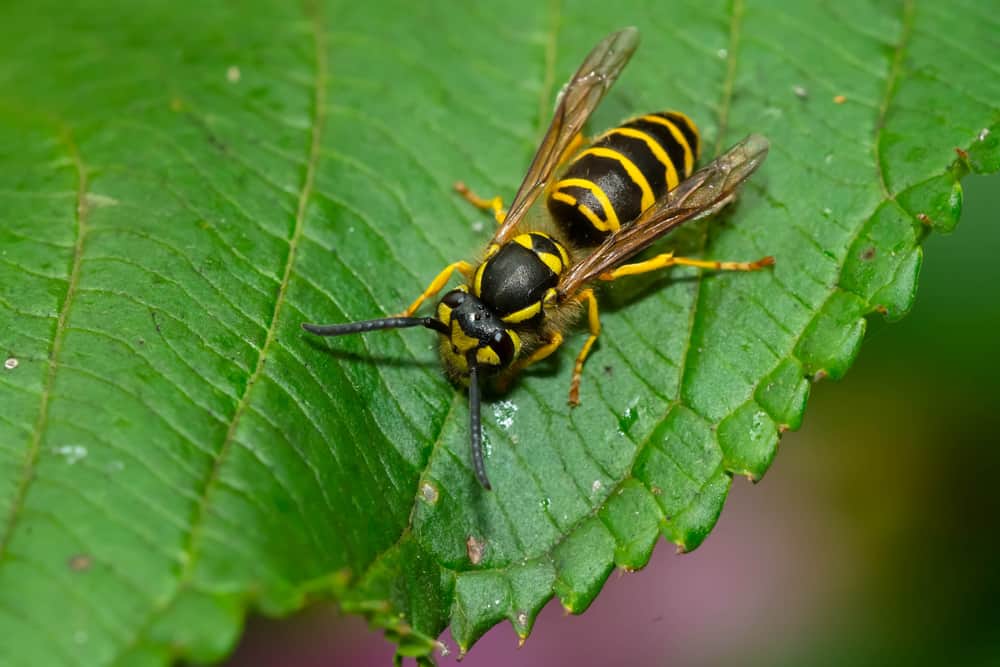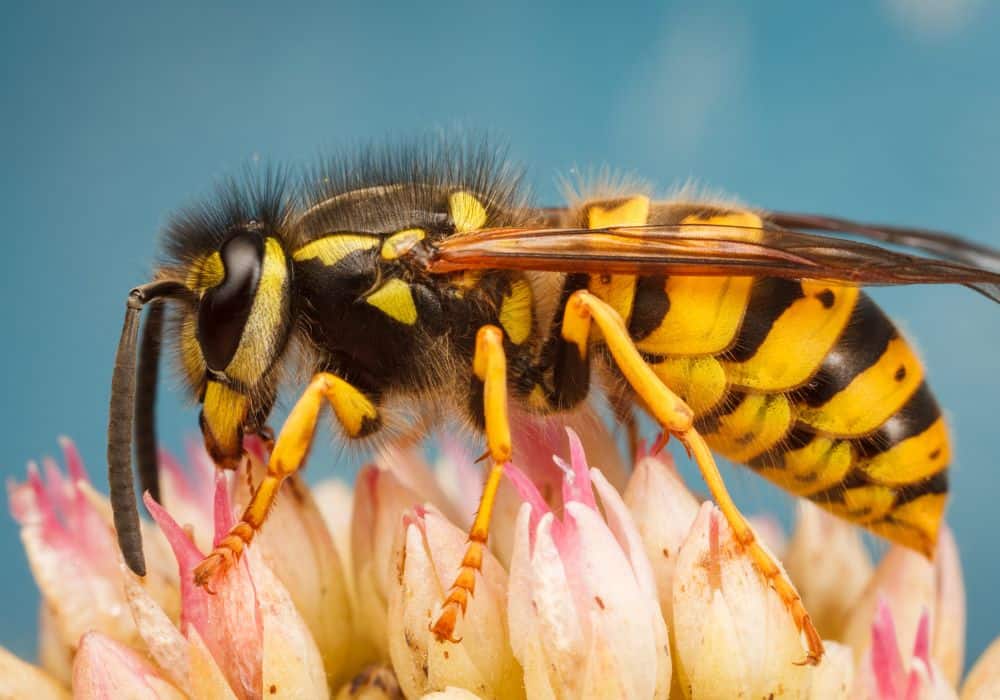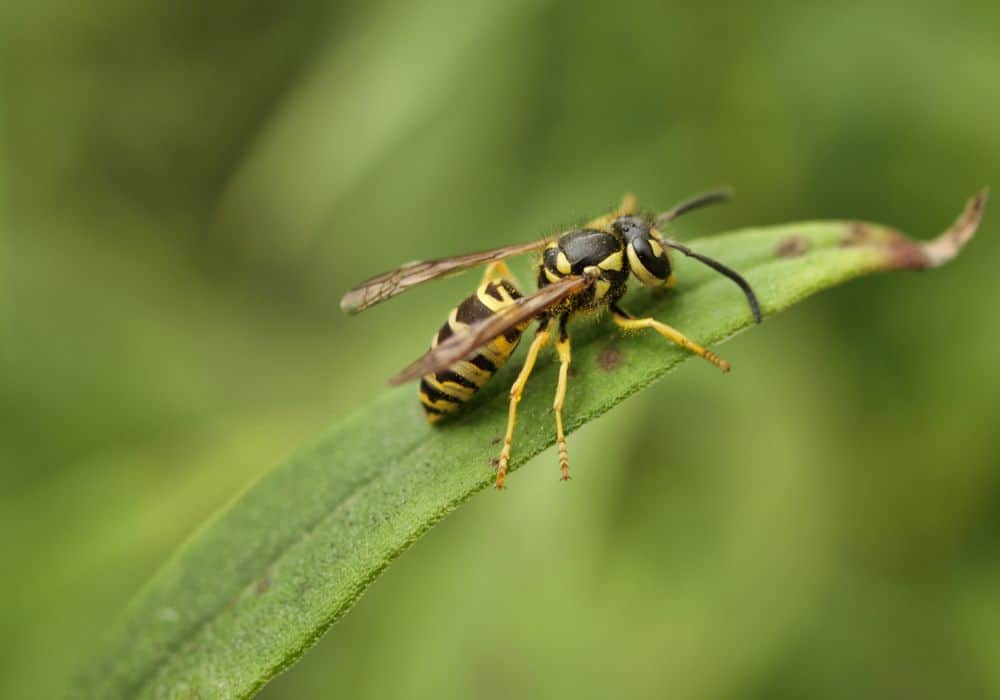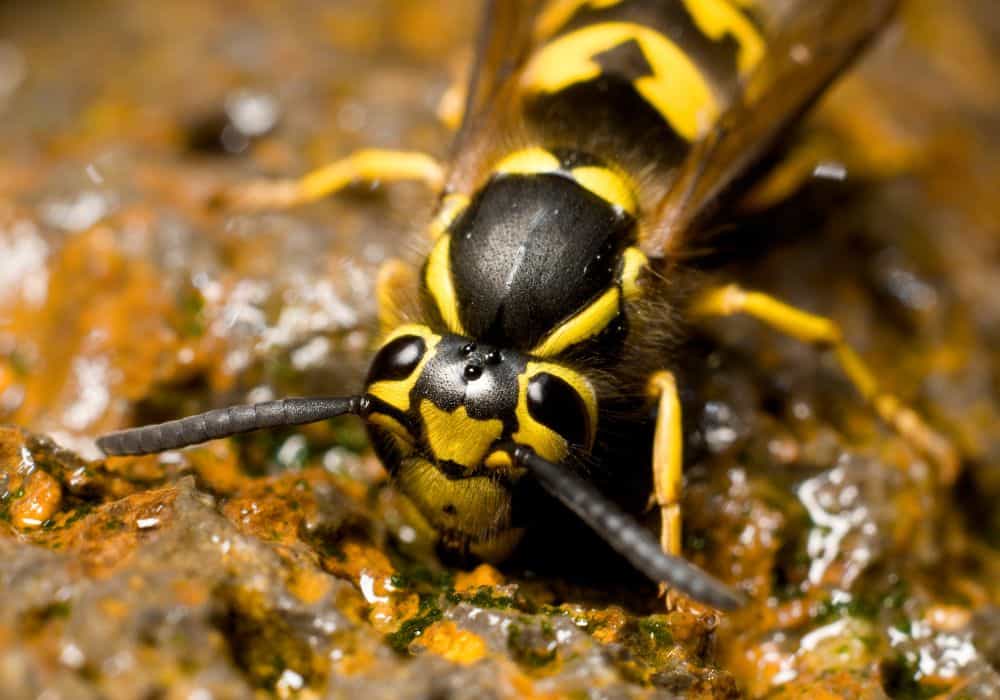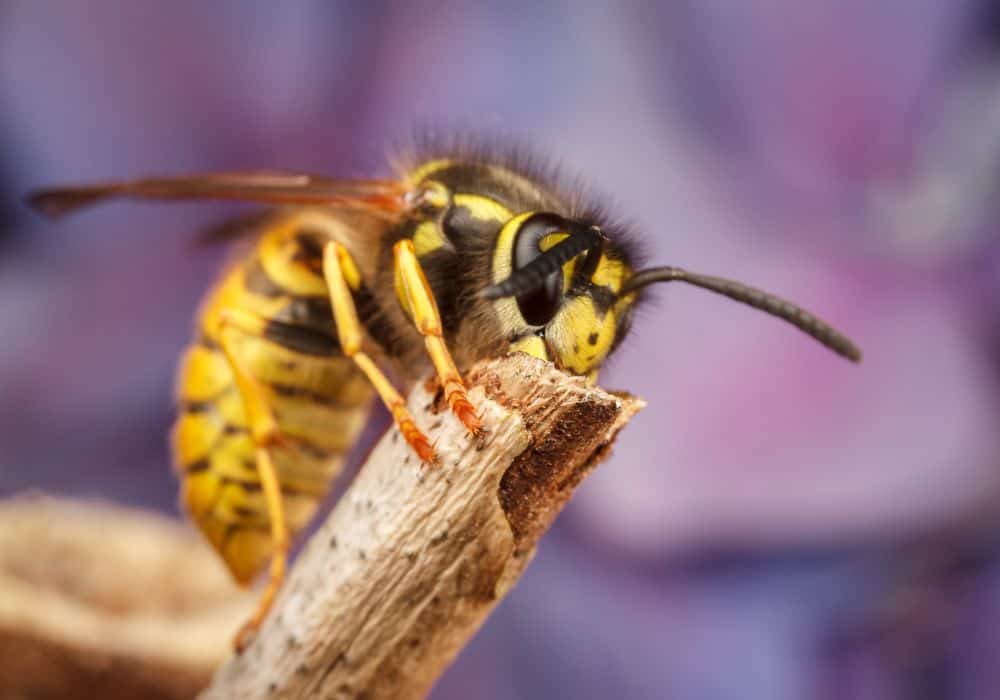Have you seen some Yellow Jackets buzzing around your yard lately? Are you wondering how they’re finding food in your neighborhood?
Yellow Jackets primarily eat plant nectar and fruit, although they’ll also snack on sugary human food and drinks if left outside. When feeding larvae, Yellow Jackets will also eat meat, fish, and other insects – both dead and alive.
Let’s learn more about the characteristics and eating habits of these bold insects.
The Physical Characteristics of Yellow Jackets
Yellow Jackets get their name from their black bodies and yellow markings—the yellow bands around their abdomen, making them look like they’re wearing a yellow coat.
The face of this wasp is also yellow with large, dark eyes. You can find long antennae prodding from the top of their heads.
Contrary to their name, there are a few types of Yellow Jackets that are white and black or marked with red.
Their bodies are divided into the head, thorax, and abdomen. Yellow jackets also have six legs and their infamous stinger since the Yellow Jacket’s stinger is not jagged, they can sting their victim multiple times and they will not die.
They have a set of fore wings and a set of smaller hind wings. These wings are unique to other wasps because they fold longitudinally when the wasp is resting.
These wasps are between 3/8 and 5/8 of an inch long. They are often mistaken for bees since they’re a similar size.
You’ll find Yellow Jackets living in large colonies, sometimes amounting to over 10,000 wasps. As they protect their queen, you’ll notice their aggression if something or someone is perceived as a threat.
The Distribution, Habitat, & Life Span of Yellow Jackets
Yellow Jackets are one of any 35-40 species of wasps. It’s important to know where they live because you’re going to want to steer clear of these aggressive insects if you see any.
Distribution
Yellow Jackets are primarily found in North America, often near humans. They prefer arid and hot climates.
These wasps stay close to home, typically searching for food within 1,000 feet of their hive. You’ll see the most Yellow Jackets in the spring and summer, as many die off in the winter. The queen will survive and begin a new nest the following spring, laying more eggs to produce worker wasps.
Habitat
Yellow Jacket nests are built underground or in hollow openings, like hollow logs, tree stumps, in attics, between walls, or inside recycling or garbage bins. They live differently than hornets, which usually nest in bushes and trees.
The queen will search for wood fibers to start a nest. Worker wasps then assist by creating a larger nest from multiple layers of paper cells, made from chewed wood mixed with saliva. These nests are built annually unless they’re in a climate with a mild-enough winter to survive.
Life Span
The Queen Yellow Jacket is the source of life for the entire hive. She will law up to 25,000 eggs in one season.
All Yellow Jackets go through the egg, larva, pupa, and adult stages. The eggs hatch into larvae, which are fed by the queen until they grow limbs and wings.
Once developed, these pupas develop further in a protective case for about three weeks. After this time, they emerge as adult Yellow Jackets.
The first emerged adults are sterile females. The queen is the only fertile female. Almost all adults Yellow Jackets assume a worker role.
Males die off sooner, while newly hatched queens leave the hive to hibernate. In the winter, most adult yellow jackets will die, leaving the queens to repopulate the area come spring.
The life span of a Yellow Jacket is fairly short. Worker wasps only live 10-22 days. The queen will live up to one year.
What Do Yellow Jackets Eat?
Yellow Jackets love to eat sweet foods that are high in sugar and carbohydrates. They will flock towards plant nectar, fruit, and alternative food sources left behind by humans – one reason you may find a hive of Yellow Jackets in an unmoved garbage bin.
If you leave out any sugary drinks, candy, cakes, veggies, ice cream, or other sweet treats, don’t be surprised if you’re met with some Yellow Jackets the next time you return.
Adult Yellow Jackets even get sugar from their larvae. The larvae give off a sugary substance that the cohabitating adults eat.
In exchange for this, the adults feed the larva food that is high in protein, like meats, insects, and fish. They may get this meal from a dead animal or live insects like caterpillars, other larvae, flies, and carrion.
Adults will prechew this food, transferring it to the larvae in the hive. This exchange is called trophallaxis. Without trophallaxis, the larvae would not get the protein they need to fully develop into a pupa and then an adult Yellow Jacket.
Any food item with sugar or protein could attract Yellowjackets if they live in the area, so be wary during picnics, barbecues, and outdoor parties.
Do Yellow Jackets Change Their Diet Seasonally?
Yellow Jackets prefer to eat flower nectar, fruit, or sap, especially in spring and summer when options abound. They will fly from plant to plant, much like honey bees, helping in pollination.
While they’re seen as a pest to some, this eating habit works wonders on gardens and farms.
To collect the sugar it needs, the Yellow Jacket will use its long tongue to reach the flower nectar.
By late summer or early fall, they find themselves with a dwindling supply of nectar and seek out alternative food sources, bringing many into contact with humans. This is why you’ll find Yellow Jackets swarming near garbage bins or any food or drinks left outside for longer periods of time. They’ve even been seen entering beehives to steal honey if no other food sources can be found.
How Much do Yellow Jackets Eat?
Yellow Jackets consume a large amount of food when you calculate their activity as a hive. In a 1,000-square-foot yard, they can eat over a pound of insects. These insects may be dead or alive.
Yellow Jackets’ Special Eating Behaviors
All Yellow Jackets have unique eating habits, from their juvenile phase into adulthood. They are social wasps, so larvae will notify adults when they’re hungry by wiggling around in their cells. Once one of the female workers sees this, she will leave the nest and look for food.
The adult female collects the food – perhaps from a meat or insect source – and chews it back at the nest. The chewed prey becomes a paste in her mouth.
As she reaches the hungry larva, she will move the larva so that it secretes a sugary liquid through salivary glands. After the adult eats this liquid, she gives the previous paste to the larva to eat. This strange exchange of food enables both the larva and adult to feed and keep each other alive.
As adults, Yellow Jackets won’t venture too far from the hive. If they can’t find any natural food sources nearby, they will show increased aggression, especially to humans who have food or drinks the wasps deem edible.
Getting Rid of Yellow Jackets in Your Yard
Yellow Jackets can become a nuisance, especially if their nest is next to your patio or garden. You can get rid of Yellow Jackets through a professional extermination company, chemicals, or home remedies.
A professional exterminator is your best bet for getting the job done and avoiding stings. If you’d prefer to try home remedies, start by eliminating the wasps’ food source. Spray for insects and avoid leaving out any human food or drinks.
You can also research how to make homemade traps that drown the wasps using bait and a bucket of water.
Finally, there are chemicals and sprays you can purchase online or at home improvement and garden stores.
Conclusion
Yellow Wasps are sometimes seen as a nuisance, but they should also be revered for being an integral part of our ecosystem. They help to pollinate many species of plants while also ridding our backyards of other bugs. All this is done while eating plant nectar, fruits, and insects.
When food sources are scarce as winter approaches, they may turn to food or drink left out in the open by humans, showing some aggression.
So long as you steer clear of them, Yellow Jackets will do more good than harm, but be sure to bring your food and drink back inside after your BBQ or picnic.
FAQ:
What Kills Yellow Jackets Naturally?
Yellow Jackets have a few natural predators. Bears, skunks, moles, shrews, and badgers all consume Yellow Jackets and wasps if the opportune moment comes.
If you want to kill Yellow Jackets with a home remedy, the best way is to remove their food sources. Make sure no garbage or food is left outside and treat your yard for the insects they may consume.
If this doesn’t work, you can try other home remedies or contract a professional to be safe and avoid Yellow Jacket stings.
What Attracts Yellow Jackets to Humans?
You may attract a Yellow Jacket if you’re holding sweet food or an open can of soda or juice. Sweet-smelling perfumes and colognes, body sprays, shampoos, and body washes will also attract Yellow Jackets.
Less sweet smells a day keep the Yellow Jackets away.
Are Yellow Jackets Beneficial to Humans?
If you can get past their stings, Yellow Jackets are actually very beneficial to humans and the environment. They feed on insects that could damage decorative plants and crops. They also pollinate flowers.
